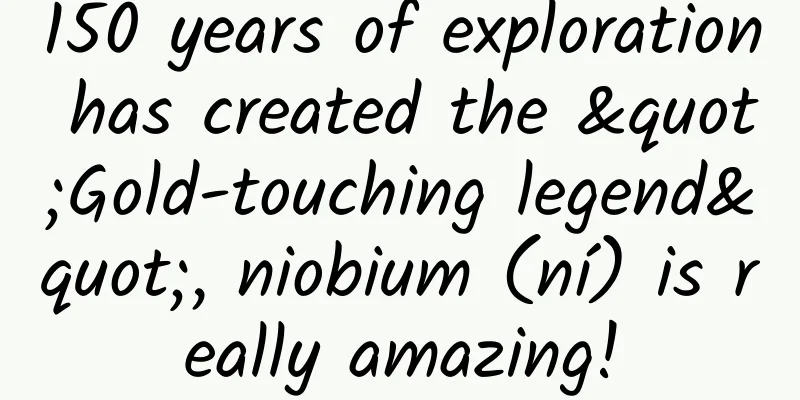150 years of exploration has created the "Gold-touching legend", niobium (ní) is really amazing!

|
The Chinese Academy of Sciences and the Qinghai Provincial Institute of Geological Survey recently announced a major discovery - the Dagele niobium deposit. This deposit is a niobium-rare earth ore that coexists with alkaline rock-carbonate rock complex. This discovery not only demonstrates the outstanding strength of China's geological science, but also provides an opportunity to break through the bottleneck of "difficult extraction and utilization" of China's existing niobium resources, and also allows us to have a deeper understanding of a magical transition metal element - niobium . What is little known is that it took more than 150 years for the element niobium to be discovered. Now it is widely used in superconductors, high-temperature alloys, improving steel properties, nuclear industry, etc., truly turning niobium into gold. PART.01 Half a century of controversy over columbite and tantalum "This guy is too stubborn. I have tried to restore it more than ten times, but still can't get the single element!" One day in early autumn of 1801, in a laboratory of a school in the suburbs of London, England, chemist Charles Hatchett was troubled by the black cubic crystals in the reagent bottle. These crystals were unknown metal oxides, which came from the ore in the museum. A week ago, when Hatchett visited the British Museum, he became very interested in the exquisite black and gold-striped ore in the display case. The curator said that it was donated to the museum by the grandson of the governor of Connecticut, USA. Hatchett, who is dedicated to ore research, asked for some samples and took them back to the school laboratory for chemical analysis. After many experiments, he separated more than 10 elements such as manganese and iron to obtain black metal oxides. Hatchett tried various methods but still failed to successfully reduce the unknown metal oxide to its elemental form. He carefully compared this substance with all the metal oxides known at the time and was surprised to find that none of them matched it. After numerous tests and verifications, Hatchett finally confirmed that this unknown metal oxide contained a brand new element. In honor of Columbus, the discoverer of the American continent, he named the new element Columbium, or Cb for short. A few years later, when Western learning spread to the East, scientists in the late Qing Dynasty translated this metal as "columbium". Charles Hatchett The early 19th century was an era of great scientific explosion in the West, with scientists racing against each other to discover elements. In the second year after Hatchett discovered columbium, Swedish chemist Ekberg published a paper claiming that he had separated a new metal element from the ore obtained from Finland. Because of its extremely strong corrosion resistance, it was named Tantalum after the hero Tantalus in Greek mythology, abbreviated as Ta, which is translated into Chinese as "tantalum". After comparing the papers of Hatchett and Ekberg, the scientific community found that the properties of columbium and tantalum were surprisingly similar, which triggered a heated discussion among chemists on whether columbium and tantalum were the same metal, with serious disagreements. In the following decades, reports of new elements with properties similar to columbium and tantalum were occasionally found, and various new names were given to them. However, after careful subsequent verification, these so-called "new elements" were eventually confirmed to be either columbium or tantalum. In 1844, German chemist Ross conducted an in-depth study on an ore from Bodenmais and successfully separated two elements with similar chemical properties. After careful identification, Ross confirmed that one of them was the known tantalum element, while the other was a completely new element. To commemorate this discovery, Ross named it Niobium, abbreviated as "Nb", which is translated into Chinese as "niobium". The root of this name comes from the name of Tantalus' daughter Niobe , implying that this new element is as precious and unique as a myth. Niobium Metal Whether "niobium" and "columbium" are the same element was not clearly answered at the time. In the following decades, Western scientists were deeply involved in the exploration of columbium, tantalum, and niobium, while also working hard to study the reduction of niobium oxides. This series of explorations and controversies made the scientific community at the time very lively, with various views and experiments emerging one after another. PART.02 One hundred years of purification and naming Since Ross discovered and named the new element niobium, the first person to make a breakthrough was the Swiss scientist Marinac. In 1866, after repeated experiments, Malinek invented the "fractional crystallization method" for effectively separating tantalum and niobium. The specific operating steps of this method are as follows: first, the oxides containing tantalum and niobium are chemically reacted with fluorides to obtain tantalum fluoride and niobium fluoride, and then tantalum fluoride and niobium fluoride are respectively introduced into hydrogen fluoride to obtain high-density elemental tantalum and low-density elemental niobium. Malinak further compared elemental niobium with the previously prepared columbium, and conducted an in-depth analysis from both the physical and chemical properties. He was surprised to find that they were actually the same element. When naming it, he thought carefully. Given that the Latin name of tantalum (Tantalus) comes from Tantalus, the son of Zeus in mythology, he thought it would be more logical and culturally meaningful to name the new element "Niobium" after Tantalus' daughter Niobe. Although Malinac's naming proposal was supported by the European scientific community, it was strongly opposed by the American scientific community. There are two reasons: first, "columbium" was named early, so it was reasonable to name it; second, "columbium" was mainly to commemorate Columbus. As the first person to discover the American continent, Columbus has always been respected by Americans. In communications and official documents, the Europeans stood firmly on the side of "niobium", while the Americans stood firm on the side of "columbium". This situation lasted for nearly a century until 1949, when the International Union of Pure and Applied Chemistry (IUPAC) held a meeting and made a ruling: the official name of element 41 in the periodic table is "niobium", while "columbium" is retained as an old name. This long-standing dispute finally came to an end. PART.03 Points of Gold Formation have Wide Application Like the discovery and naming of niobium, the application of niobium also went through a relatively long process. At the beginning of the 20th century, niobium made its first appearance in the manufacture of incandescent lamps. However, this short-lived attempt was soon replaced by tungsten, which has a higher melting point and is more suitable for the manufacture of incandescent lamps. More than 20 years later, niobium once again attracted people's attention because of its unique property of enhancing the strength of steel, which in turn promoted its widespread application in the steel industry. More than 20 years later, the application of tantalum-niobium high-temperature alloys has made significant progress. **After entering the new century, niobium has opened the door to progress like a shining golden key. **As people further study the physical and chemical properties of metallic niobium, such as high temperature resistance, corrosion resistance, and excellent electrical conductivity, it has been widely used in many fields such as aerospace, superconducting materials, etc., creating unimaginable value for the world. Niobium is widely used in the industrial field and is known as the "industrial MSG" . Due to its high strength, high melting point, corrosion resistance and other characteristics, niobium and its compounds play an important role in many fields such as steel, alloys, ceramics, and electronics. Adding a small amount of niobium to steel can significantly improve the strength and corrosion resistance of the steel. The most widely used application in this regard is in automobiles. Adding niobium to alloys can improve the alloy's high temperature resistance. In the fields of ceramics and electronics, niobium compounds also play an irreplaceable role. Auto parts have better performance due to the addition of niobium. Source: China Mining Network What is even more amazing is that, under certain special circumstances, niobium can even exert a magical effect of "turning anything into gold". In the fields of superconducting materials and catalysts, the addition of niobium can significantly improve the performance of materials and achieve some seemingly impossible technological breakthroughs. For example, in superconducting materials, the addition of niobium can increase the critical temperature of superconductors, allowing superconducting technology to be applied at higher temperatures; in the field of catalysts, niobium compounds can act as efficient catalysts to promote chemical reactions and improve production efficiency. In the future development of science and technology, niobium, which has been discovered and named for more than 150 years, will continue to play an irreplaceable role and contribute more to the progress of human society. References: 1. "The History of Niobium as a Microalloying Element", Opening Speech of the 2001 Global Niobium Conference, by Lutz Meyer 2. "Research on Exploration, Development and Investment of Global Niobium Resources", author Liu Fei, "China Mining" 2013, No. 07 3. "Application and Development of Niobium", author Wang Yongyue, "Ningxia Science and Technology", issue 4, 1997 Author: Wei Deyong, member of Shenzhen Writers Association, Guangdong Editor: Dong Xiaoxian |
<<: Why are my allergy symptoms so severe but cannot be diagnosed?
Recommend
E-commerce operations: analysis of the promotion system!
E-commerce has been integrated into our lives and...
How to increase followers quickly on Tik Tok? 7 tips to increase followers on Douyin
The popular short video Douyin has made a lot of ...
How to improve the click-through rate of Guangdiantong ads? A few simple tips to teach you how to apply what you have learned.
When it comes to optimizing click-through rate , ...
Why is Samsung in such a hurry to compete with Apple, Google, Dell, etc.?
[[143070]] Today, this saying should also be rega...
Lantu Auto: In March 2025, Lantu Auto sales reached 10,012 units, a year-on-year increase of 64%, and cumulative production will exceed 200,000
According to recent news, Lantu Auto announced it...
Do you take oseltamivir as a "magic flu drug" when you have a fever? You should understand this before taking it →
Speaking of Oseltamivir I believe everyone is fam...
The battle for attention is escalating: the 100,000+ era is over, the 1 million+ era is here
With the improvement of mobile Internet infrastru...
The realm of "stealing skills": creating oneself from classics | Yihai Shizhen
How did the talented painter Lippi learn from oth...
Refined operation strategy for users with repurchase rate of over 95%
What I want to share today is the refined operati...
A 600 million light-year-long cosmic void, new findings on dark energy: the relationship between void mass and light!
The Dark Energy Survey (DES) uses patterns in mac...
A complete guide to writing PR articles for APP promotion, 90% of good operators know...
"The successful APP soft article marketing a...
Apple China makes another big move: iOS games require a license to be listed on the App Store
Recently, Apple's Chinese App Store has remov...
Lenovo's mobile phone business is unlikely to replicate the PC myth after missing out on a good development opportunity
According to the latest data from IDC, Lenovo'...
How to spend the May Day holiday? Many places advocate taking local holidays during the epidemic. Please keep the travel safety tips →
According to the Notice of the General Office of ...
Luxury cars priced over 1.3 million will be subject to a 10% consumption tax
Recently, the Ministry of Finance and the State A...









